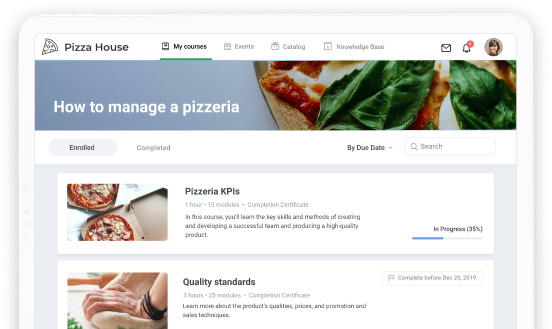Employee Training Metrics: How to Measure eLearning Effectiveness

When you conduct training in your company, you expect to increase employee performance and enhance your business overall. But how can you measure success in corporate training? Did your employees learn what they were supposed to? Did they apply the new knowledge on the job? Did they meet a business goal? And, finally, was this training worth your company’s investment?
To answer all these questions, you need to know how to measure training effectiveness.
What Is Training Effectiveness?
Training effectiveness is a measure of the degree to which learning improves employee performance; for instance, how your team members enhanced their sales and communication skills, increased their productivity, or met a business goal.
To measure training effectiveness, you can use training evaluation metrics. Let’s have a look at what they are and how they can help you with online training in your company.
What Is a Training Metric?
A training metric is a quantifiable measure used to track and assess the results of the training process.
Training metrics can be used for evaluating different aspects of learning. For example, you can track test scores, time spent on each activity, and how many attempts each learner required to achieve a passing score. But ultimately, all of them are aimed to assess the training effectiveness.
What Are Examples of Training Metrics?
There are a lot of training effectiveness metrics out there, but the ‘starter pack’ would include:
- Pass or fail rate, which applies to tests and quizzes and their successful completion.
- Scoring, which helps you estimate learners’ performance and adjust the difficulty level of a quiz or test if needed.
- Training experience satisfaction, which identifies how learners perceive training and what requires improvement.
- Training completion rate, which shows the number of learners who finished a course.
- Learning dropout rate, which shows the number of people who didn’t complete a course or decided to leave it. This can indicate problems with the content or browser compatibility.
- Post-training performance, which shows the effectiveness of training and how employee performance has improved (an increase in work efficiency, the number of calls, client contacts, sales, etc.)
Another important metric is a return on investment (ROI). ROI compares the financial value of the learning outcomes against the investment you made to achieve those results.
ROI is used at the very end of the evaluation process, so we’ll elaborate on it later. Now, let’s go back to the beginning and see how to pave the way for proper training evaluation.
How to Identify the Right Metrics for Your Training
These are several criteria that help you recognize the appropriate metrics to assess your training:
- Proper metrics highlight pain points and what employees are struggling with.
- You can validate these learning metrics and identify the impact of training on employee and business performance.
- If you include them in the job performance assessment, they will motivate people and drive the business forward. So, employee performance metrics should be objective and quantifiable.
To understand what metrics will be particularly relevant for training in your company, follow these steps.
Ask what stakeholders need
To lay out a training evaluation strategy, first, reconcile the expected metrics with key stakeholders. What do they consider the most important indicators? What will be the priorities for assessment? Keep stakeholders informed along the way and communicate your vision of training results clearly.
Keep track of departments
If your company is large, it will be necessary to track how well different departments perform and what factors impact it. You should track how they enroll in a course, complete it, and how many overdue assignments they have. In eLearning, an LMS can help you with that. It will track and organize the stats on the course that was assigned, attempted, and completed with a metric called Department/Group progress.
To set yourself up for training for success, you need to have departments heads realize the importance of training. Let them know about training objectives and how they can improve group performance.
Consider your model of training
Metrics can vary depending on the type of training: synchronous, asynchronous, or blended. For example, if you prompt learners to participate in webinars as well as taking online courses, attendance and participation should also be taken into account.
In asynchronous training, when the topic of a course is demanding and aims to change post-training behavior, you should divide the course into modules and track how learners progress through them. It will take some time and effort from employees to grasp and retain new knowledge. So, the metrics you’ll need will include the number of modules completed, the time spent on them, scores attained in tests after each module, etc.
You can use the Kirkpatrick model to build up a strategy to measure training effectiveness. Below, we’ll explain precisely which training metrics you can implement with this model and how to evaluate training with the help of an LMS.
How to Measure Training Effectiveness?
The most widely used model to evaluate training effectiveness is the Kirkpatrick Model. It was created by Dr. Donald Kirkpatrick, past president of the American Society for Training and Development (ASTD), in the 1950s. This model allows you to objectively assess a training program and shows its value to the business.
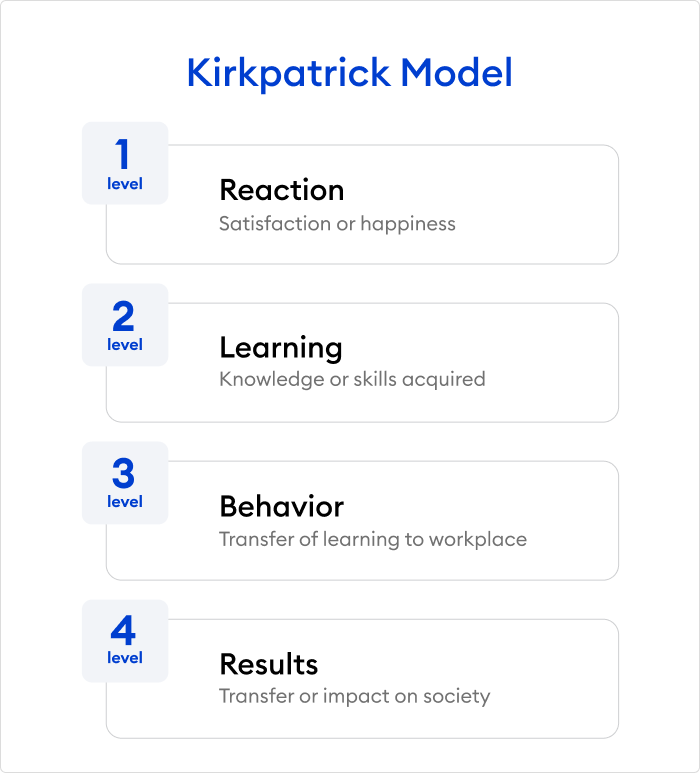
Let’s have a closer look at the four levels of the Kirkpatrick Model:
Level 1 — Reaction
The objective for this level is to define how learners feel about the training. Did they enjoy it and find it useful for their work? This kind of evaluation is aimed at getting feedback from learners about the courses they’ve completed, and see which training materials truly work and which ones should be improved for future use.
How to measure
To evaluate your employees’ reaction you can use:
- face-to-face interviews;
- printed surveys and questionnaires;
- online polls and feedback forms.
How LMS training metrics can help
An LMS allows you to carry out reaction surveys and get user feedback. You can create questionnaires right in the system and easily track the results, without having to manage and transcribe paper forms.
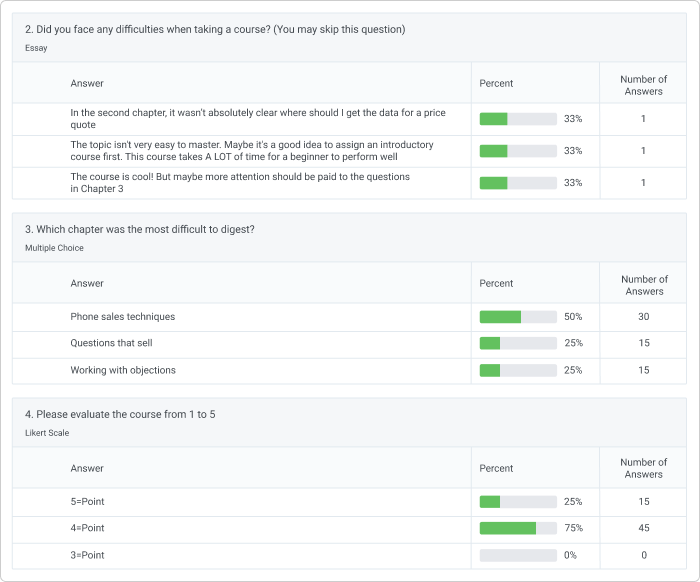
This training metric was used at the end of employee training in HealthHelp, working in the field of healthcare utilization management. The survey showed that the newly trained staff started feeling much better prepared, and their readiness for the job has risen from 80% to 87.5% so far.
Sample survey questions
- What did you enjoy most about the training?
- How much new information did you receive?
- Was the information actionable? How relevant is it to your job?
- Were you engaged with the content?
- Was the training well-organized and well-run?
- Did you face any difficulties when taking the course?
- What could have been improved?
Level 2 — Learning
At this level you evaluate the increase in knowledge, skills, and attitudes after training. Did your employees learn what was planned? What did they gain from the course?
How to measure
To check your employees’ knowledge you can use:
- written exams;
- online tests and quizzes;
- real or simulated tasks.
How LMS training metrics can help
With iSpring Learn, you can measure how much your employees have learned and track learners’ progress on every assessment.
There is a whole set of LMS training metrics that will help you evaluate employees’ achievements.
1. Progress & Completion Rates
These metrics are the starting point in measuring training effectiveness on the second level. You can keep track of how often and how successfully learners study the content.
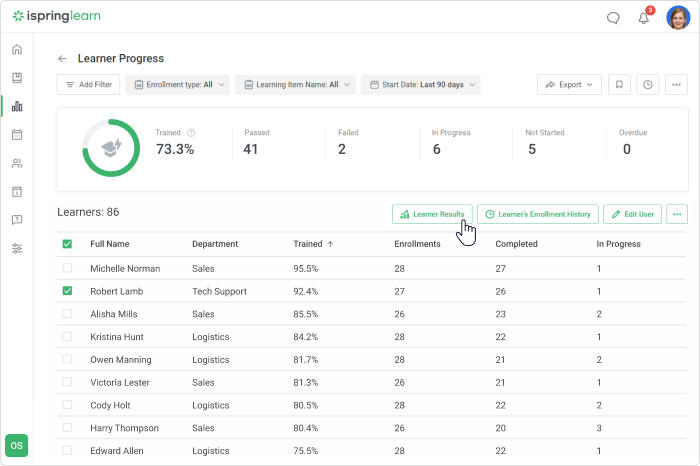
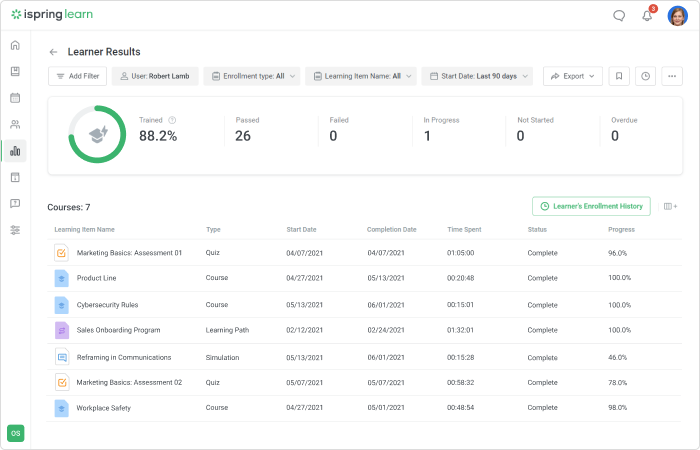
Useful tip: If it’s been a long time since the course was assigned, but users make slow progress, don’t ignore this. Perhaps the employees lack motivation to study. First of all, you need to figure out why they are not interested in learning. To find out the reason, you can conduct a survey in the LMS.
2. Score Results
This is one of the most important employee training metrics, as it gives an overview of the learning program’s effectiveness.
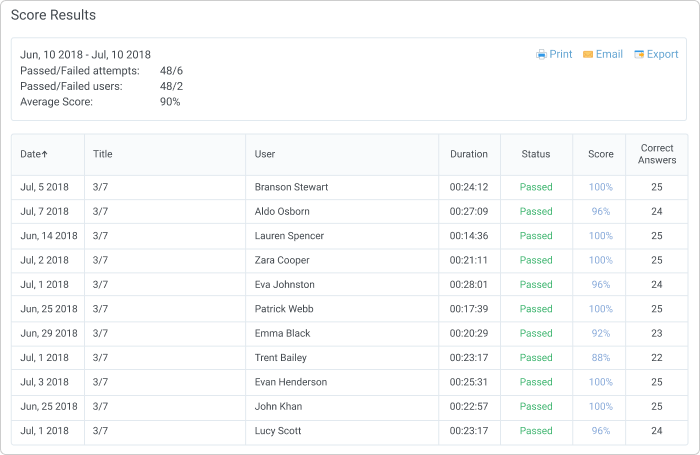
Useful tip: To assess employees’ progress more objectively, use a test before the training (pre-test) and after the training (post-test). It will give you insights into how much the learners improve.
3. Attempts & Answer Breakdown
The Attempt Detail metric shows the answers of a selected user on a certain quiz. You can see where a learner was mistaken and how many attempts they made. This metric will help you understand in which subjects the learner still has poor knowledge and, if needed, assign them additional material for learning.
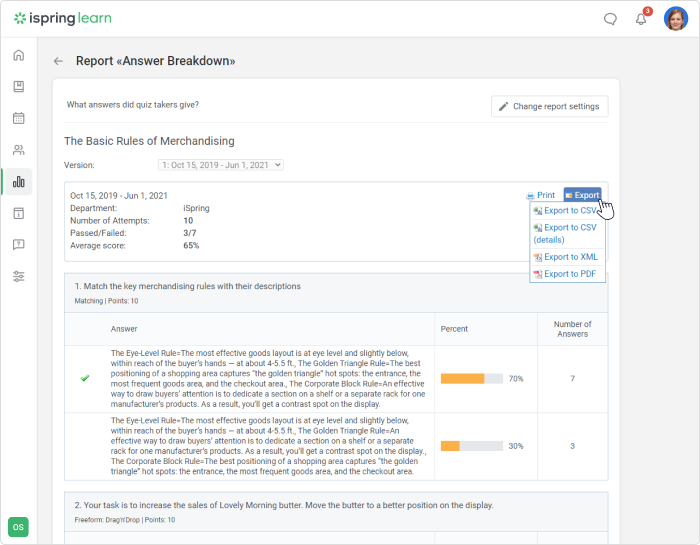
Useful tip: Check out the Answer Breakdown metric to see information on the average score and users’ answers for each question. If you notice that a high number of users gave a wrong answer on the same question, you need to make sure that the task definition in your test is clear. If it is OK, look through the course content — perhaps the topic was not explained clearly enough.
To learn about other LMS training metrics, see the full guide on the LMS reports.
Level 3 — Behavior
After assessing learners’ knowledge, it’s crucial to check if they’re applying it in the workplace. You need to evaluate how the training has influenced your employees’ performance. Does the learner use what they’ve learned in their work? Are they able to transfer the new knowledge to a specific situation?
To check your employees’ learning transfer you can use:
- printed or online self-assessment questionnaires;
- interviews with supervisors and colleagues;
- сustomer surveys, comments, or complaints;
- on-the-job observation checklists and rubrics.
- data from work processes (call resolution time, errors rates, etc.)
Remember that when you assess behavior, you are measuring the effect of both the training and the work environment, such as whether or not managers support the use of new skills and knowledge on the job.
Level 4 — Results
At this level, you need to find out how behavioral changes affect the business. This returns you to the business goals for the training set in the beginning. Are your employees working faster? Is the problem rate going down? Has the company revenue increased?
Business results typically refer to several categories:
Lower costs
For example, MW-Light, a major producer of decorative lighting fixtures, moved a part of their training online. They created a unified training program including 50 product knowledge e-courses and 3 programs on sales techniques and started teaching salespeople from regional affiliates with iSpring Learn LMS. Overall, the company managed to cut down training costs per employee by 20 times.
Also read: Retail Sales Training – How to Move It Online
Improved quality
HealthHelp also decided to shift a part of their training online. As a result, they improved employee performance, raised productivity levels at a faster rate, boosted employee retention, and enhanced clinical knowledge.
Time reduction
The world’s largest healthcare company, Johnson & Johnson, also achieved good results after revamping their training program. The company needed to provide training for 400 sales reps on various product lines. Business coaches traveled across different regions to host face-to-face courses and graded employees’ tests manually. It took an average of three months to provide certification training. After transitioning from a paper exam to online assessments, the company reduced the attestation period from three months to two days.
Higher income
Quantifying the results is necessary to calculate the return on investment (ROI). Did the outcomes after training justify its cost?
Calculating ROI is actually quite simple. The formula is:
| ROI (%) = [(Total Program Benefits – Total Program Costs) / Total Program Costs] *100, |
where Total Program Benefits means the profit produced for the company by the employee over a year as a result of, for example:
- increased sales (versus pre-training performance);
- fewer errors;
- increased customer satisfaction;
- revenue gains.
The most challenging part of an ROI study is getting reliable estimates for the financial benefits. Ask the accounting department to help.
Total Program Costs involve all the training expenses for the same period, including
- initial needs assessment;
- software or equipment expenses;
- learning content;
- travel and infrastructure costs;
- instructor costs;
- participant salaries.
Let’s take an example.
After training, the annual profit increased by $15,000. The total cost for the learning program was $6,000. So you can calculate the ROI like this: ROI (%) = [($15,000 – $6,000) / $6,000] *100 = 150% Here, a 150% ROI means that you received $1.50 of profit for every dollar invested in employee training. |
If the ROI is over 100%, the program has a net benefit, and if the result is under 100%, the program has a net cost.
What Are the Other Training Evaluation Models?
There are other approaches to evaluate learning besides the Kirkpatrick model. Let’s take a brief look at a couple of them.
The Learning-Transfer Evaluation Model (LTEM)
Dr. Will Thalheimer, instructional designer and consultant, developed another multitiered training evaluation model. It unites the processes of learning on the one hand and transferring new knowledge to work operations on the other.
LTEM consists of the following eight tiers:
- Attendance (i.e., signing up for the course or attending live training).
- Activity (interest, attention, and participation).
- Learner perceptions (i.e., motivation to apply for the course and further satisfaction with it).
- Knowledge (this signifies knowledge of terminology).
- Decision-making competence (implementing knowledge in realistic scenarios).
- Task competence (i.e., remembered relevant actions in certain situations).
- Transfer (a learner applies knowledge in work with assistance or on their own).
- Effects of transfer (assessing the impact of knowledge transfer).
In LTEM, stages 1-5 belong to the learning portion, and stages 7-8 represent the outcomes of the learning in the work process. This model examines the adequacy of various factors in each of the stages and can be very useful as an instructional design planning tool.
The Success Case Method (SCM)
The Success Case Method, proposed by Robert Brinkerhoff, focuses on studying the ups and downs of a training project. By means of surveys, it assesses the experience of those individuals and teams who succeeded in learning and those who don’t. Thus, this approach is not driven by survivorship bias and aims to learn from wins and mistakes. Specifically, it helps to reveal organizational causes, processes, and resources that impede or help the training process.
You can apply SCM to both a standalone training session and an entire training program. Here are the five steps to follow:
- Plan your success study.
- Define success criteria and deciding on the desired impact.
- Prepare a survey that identifies best-case and worst-case scenarios.
- Describe success and nonsuccess cases, interviewing people.
- Arrive at conclusions and recommendations for stakeholders.
You should learn the differences between the cases and understand why training works or doesn’t work for any particular person. The Success Case Method is useful for detecting the factors within an organization that facilitate good results or result in poor performance.
Learn more about training evaluation in this article.
To Sum Up
It is very important to analyze the effectiveness of your learning strategy to show that it is producing value for the company. Evaluation will also help you identify any shortcomings, so you can make improvements to maximize the value of training for both the learners and the company.
Choosing an LMS with an extensive reporting capability and survey engine will help you make the process efficient by automating many of the measurement tasks.
Want to track learners’ progress in real time and experience the many other benefits of an LMS? Subscribe for a free 30-day trial of iSpring Learn.

